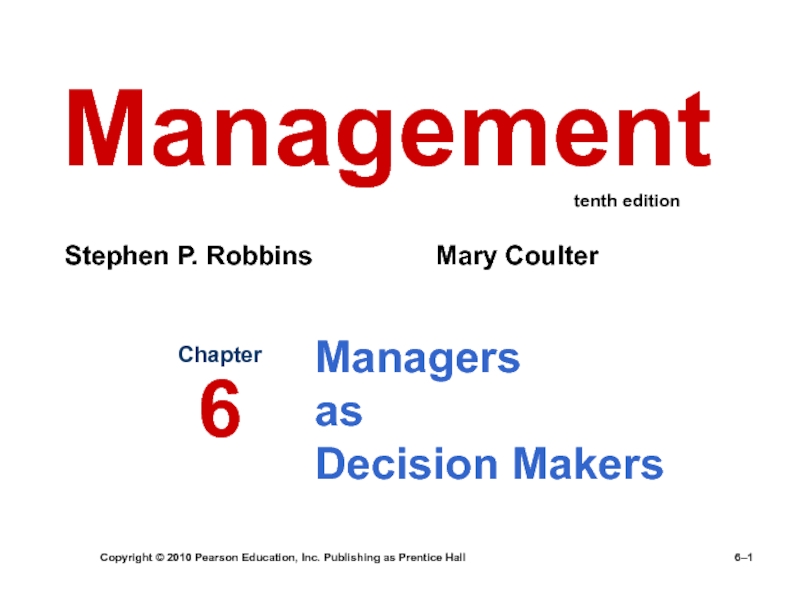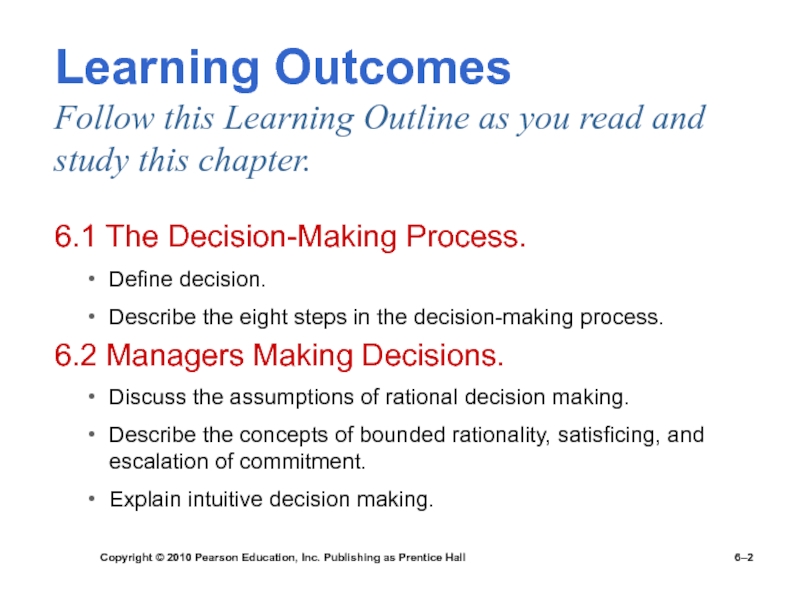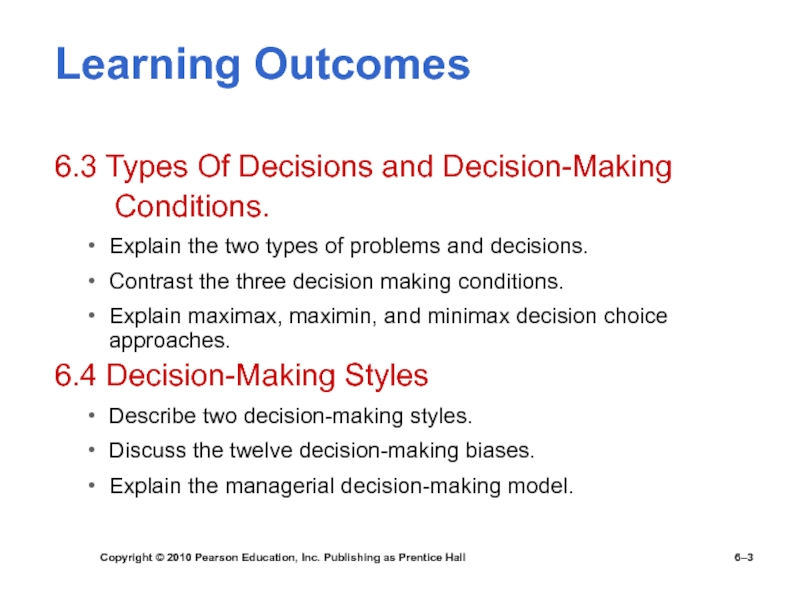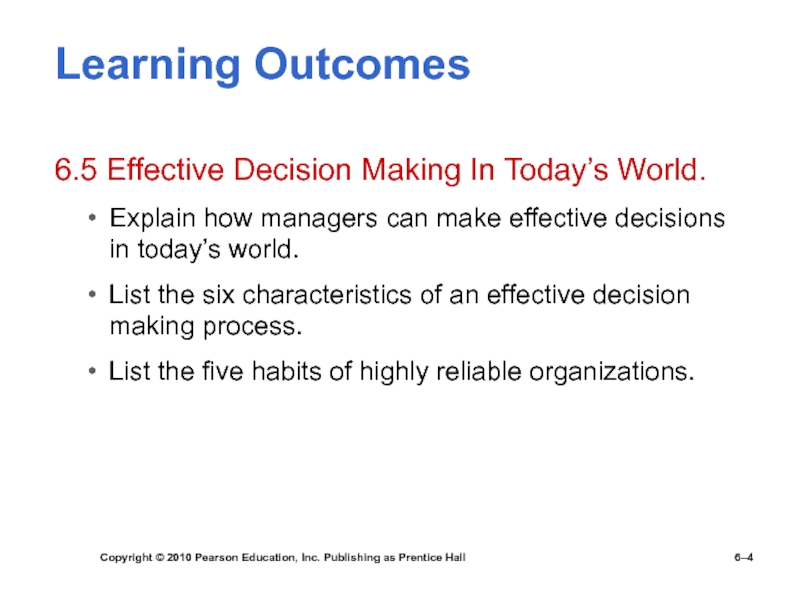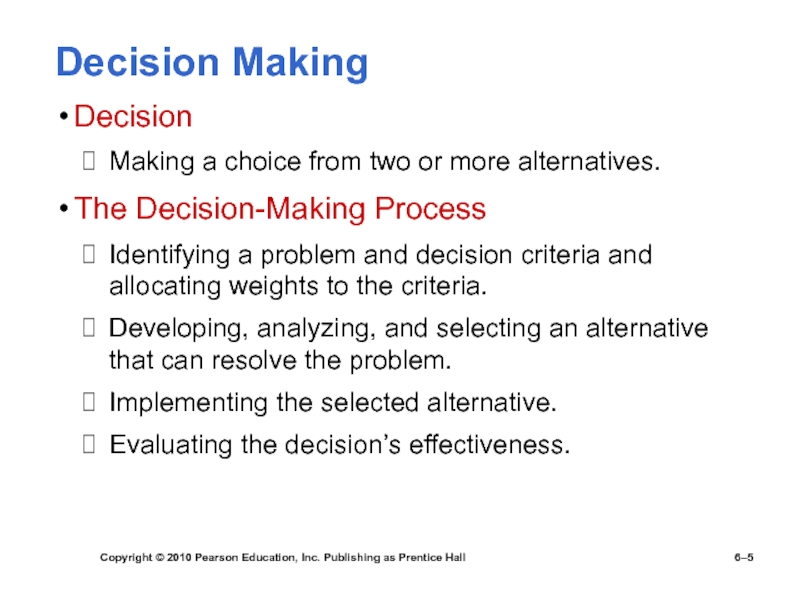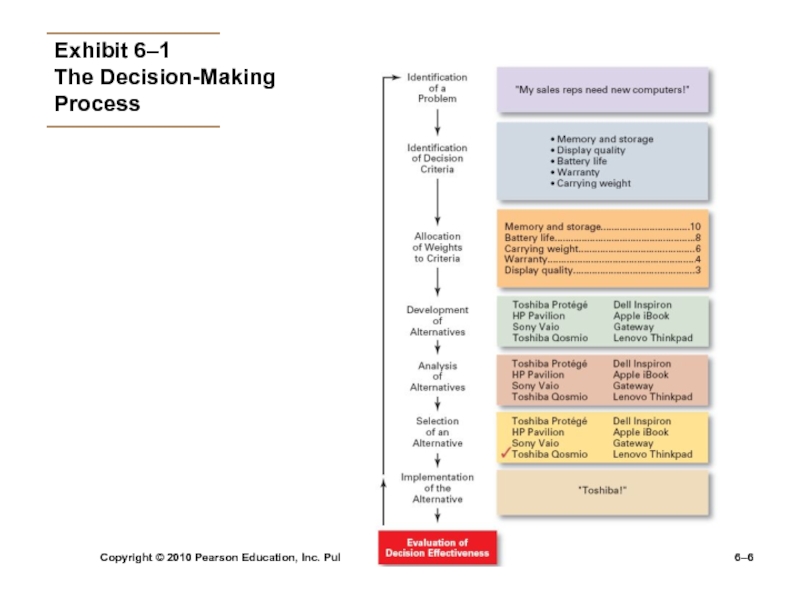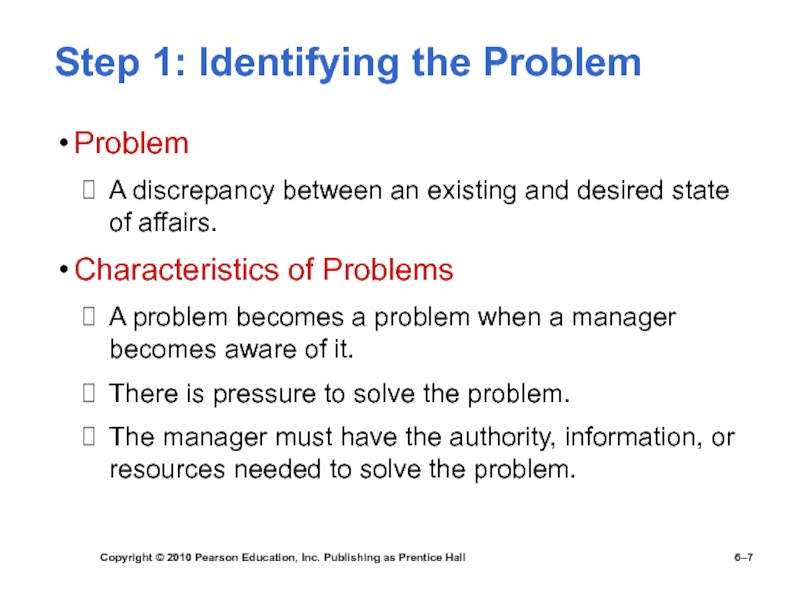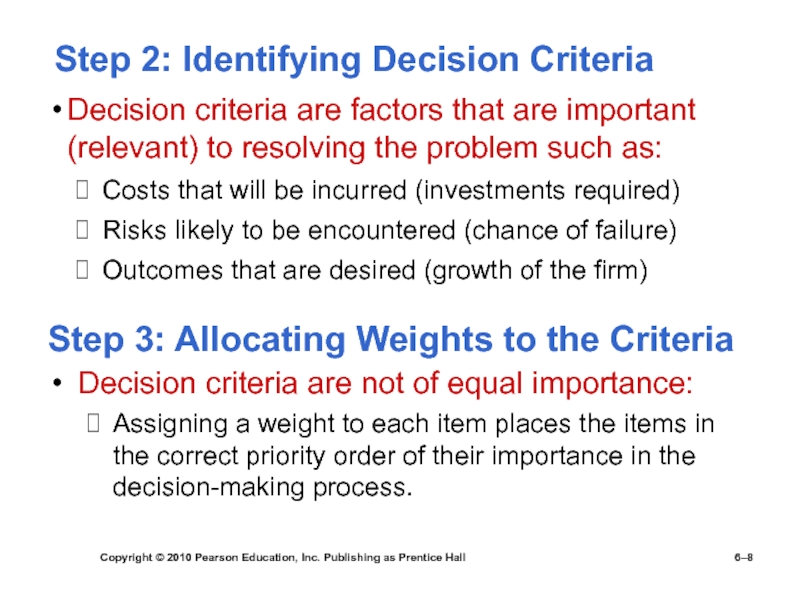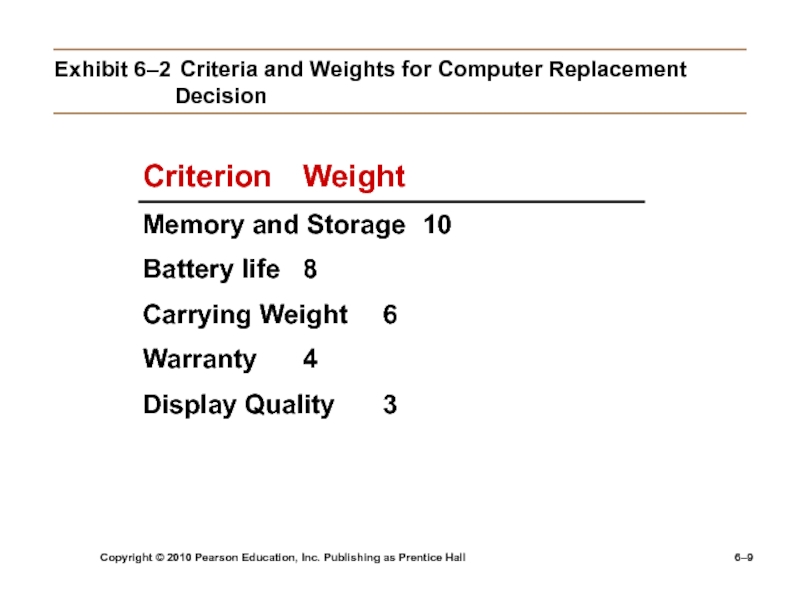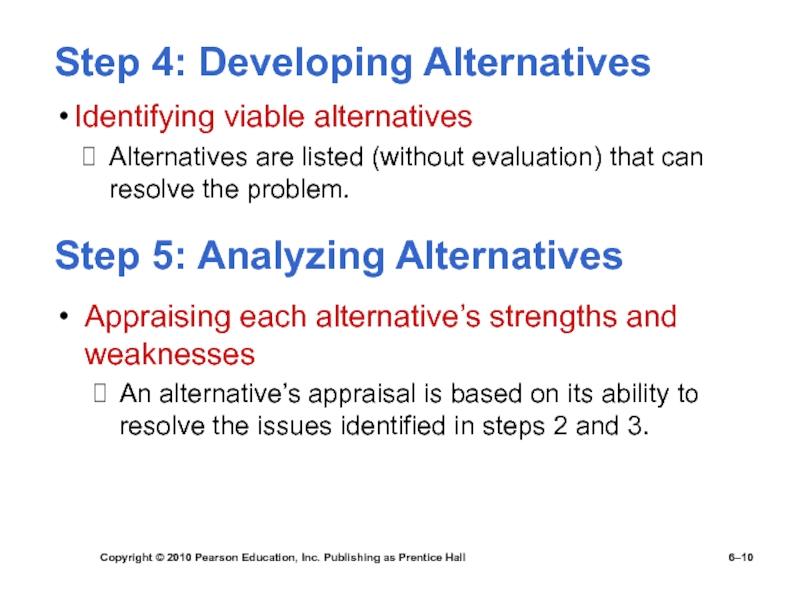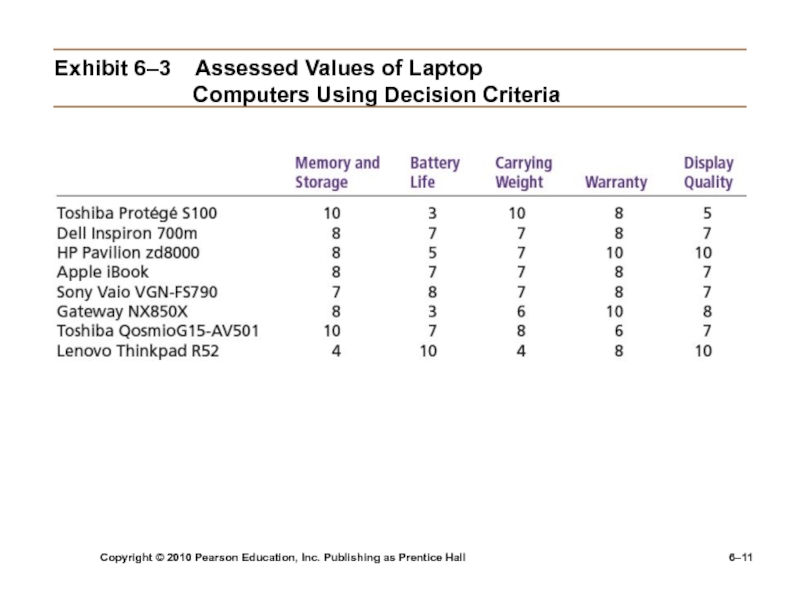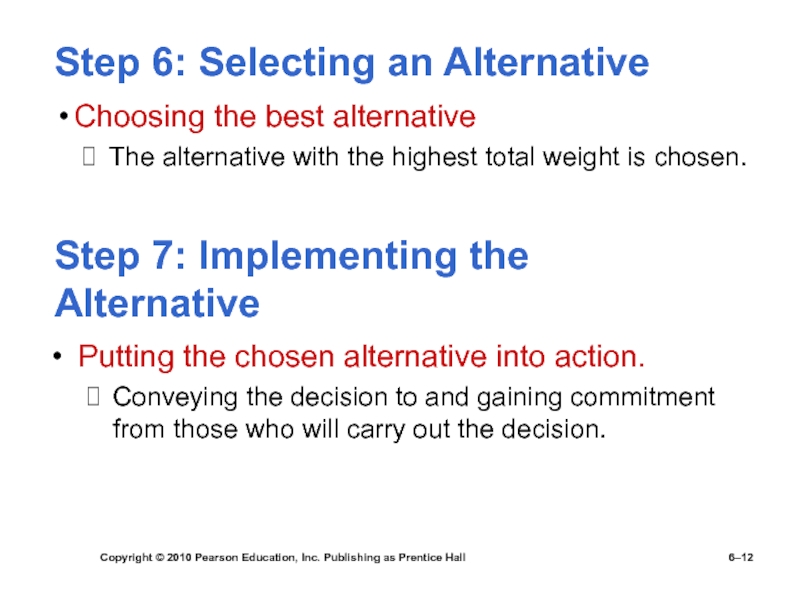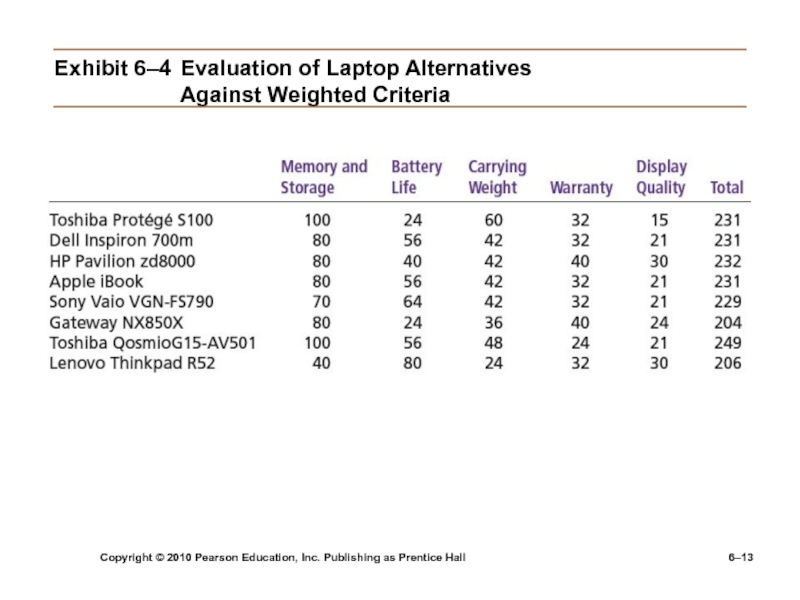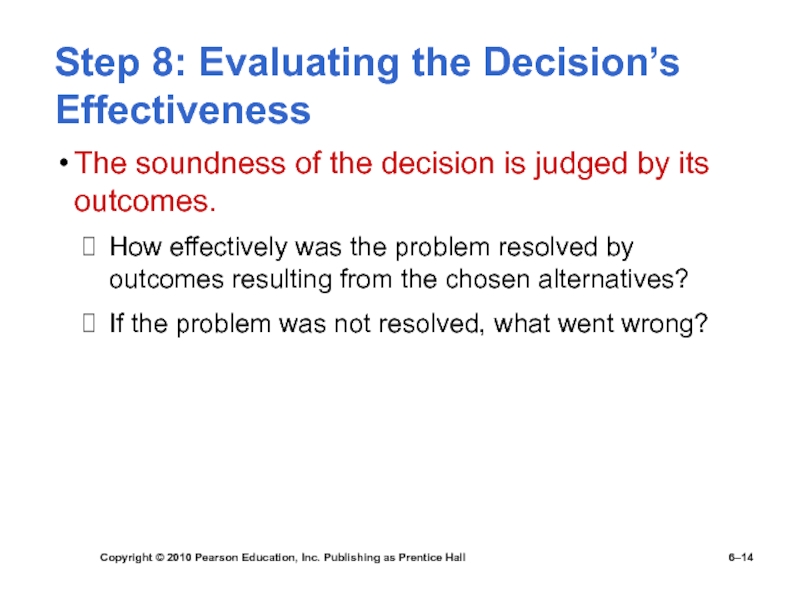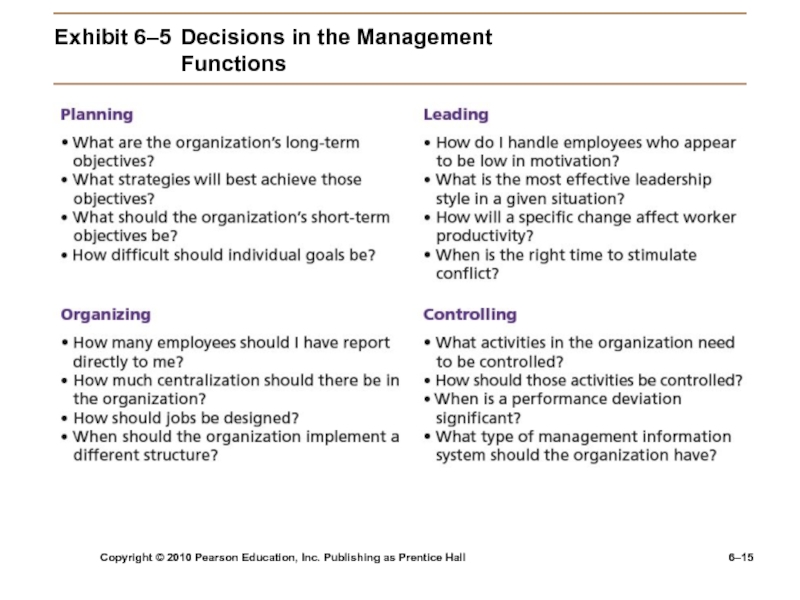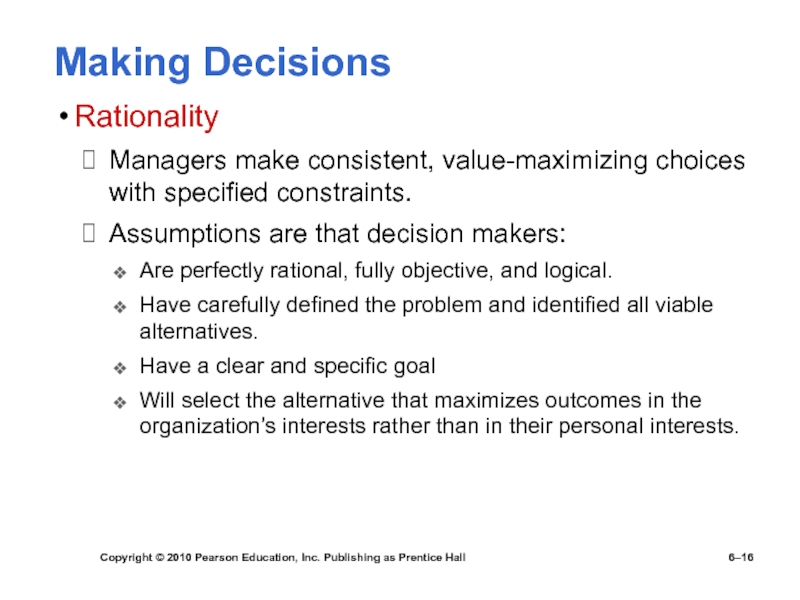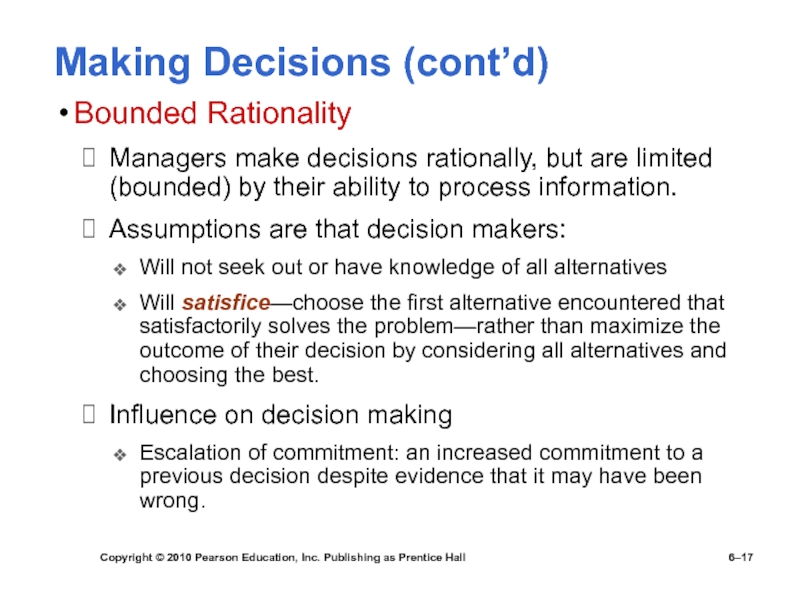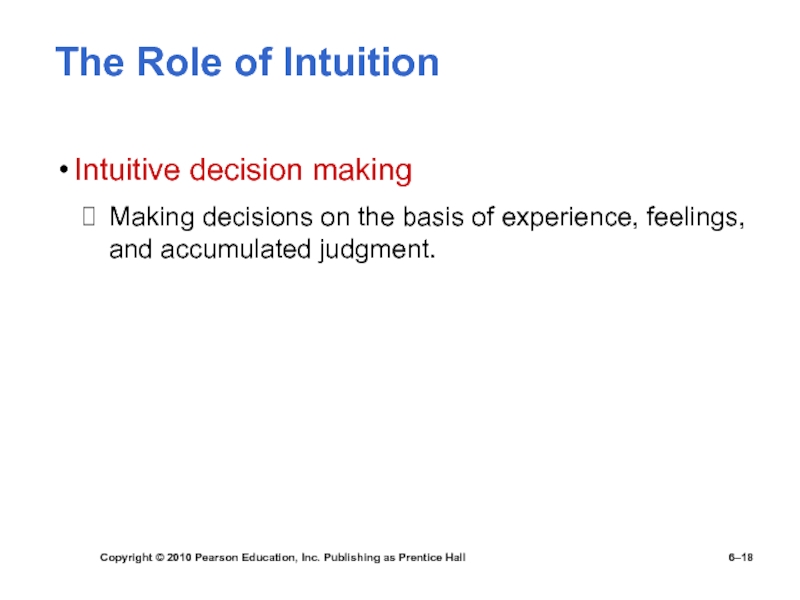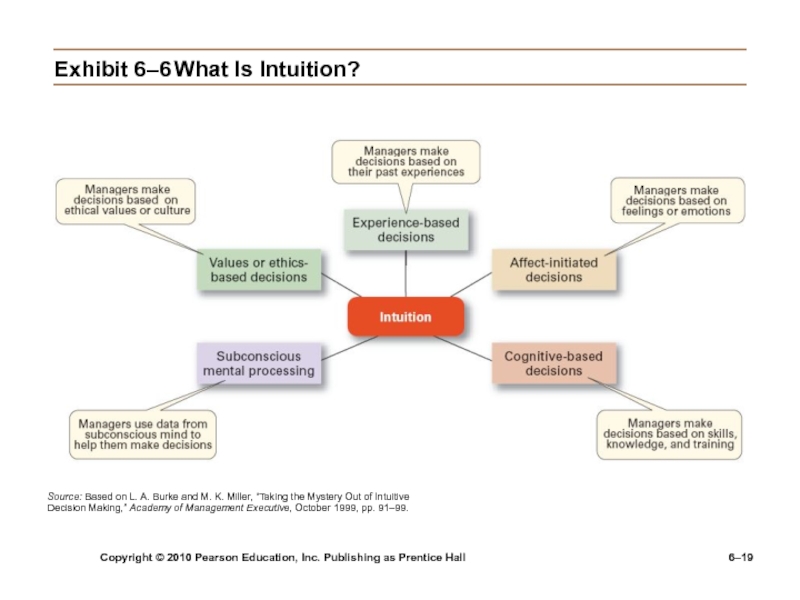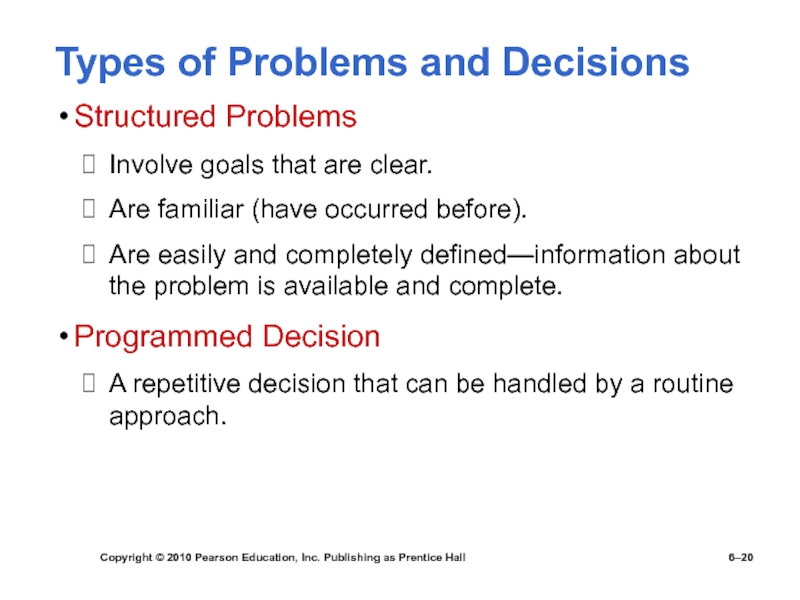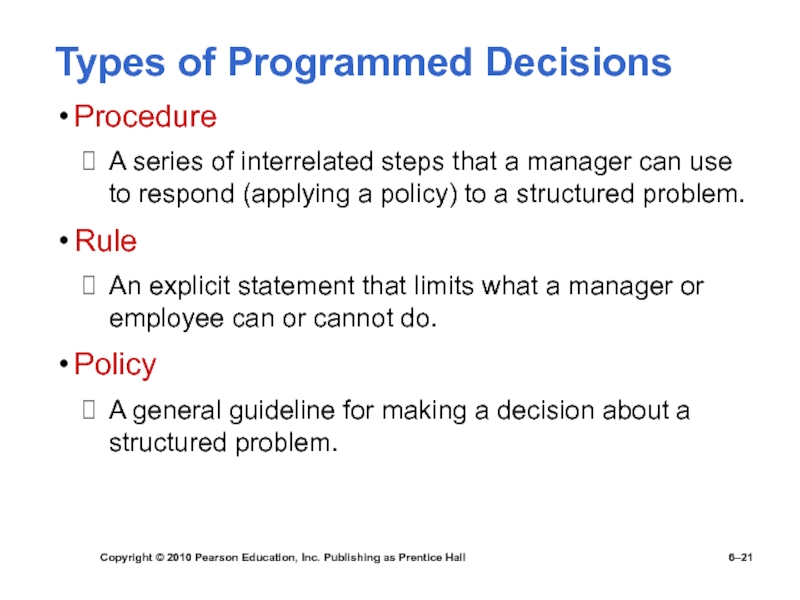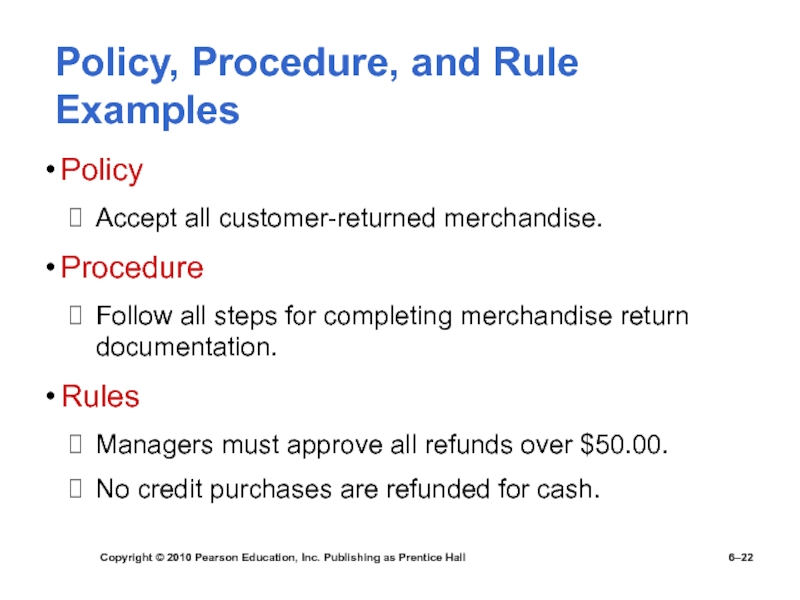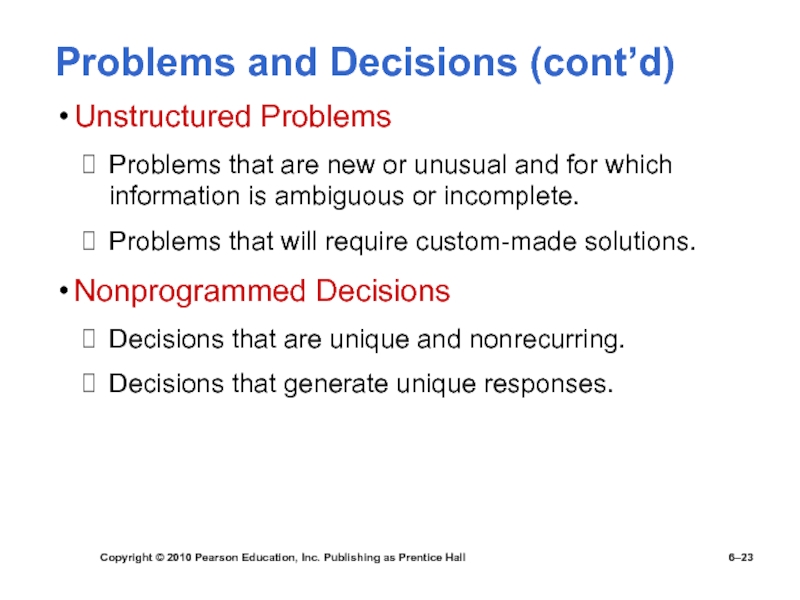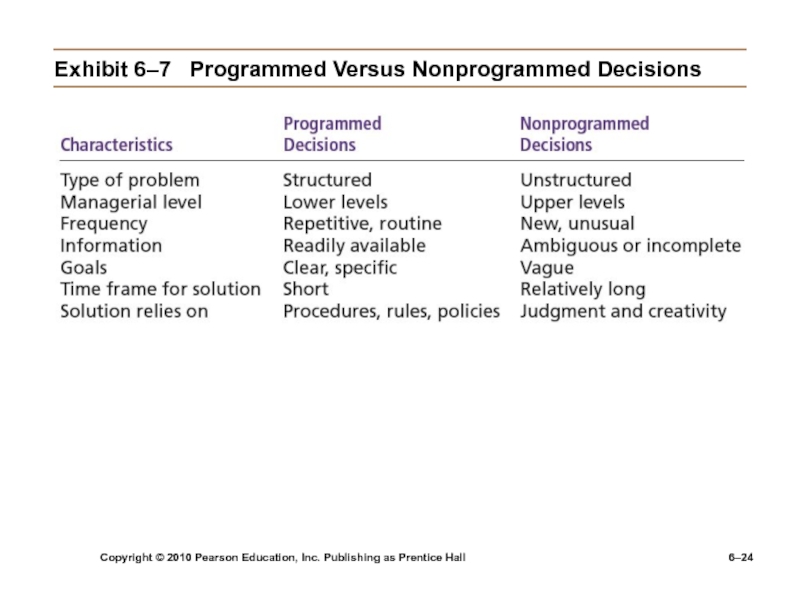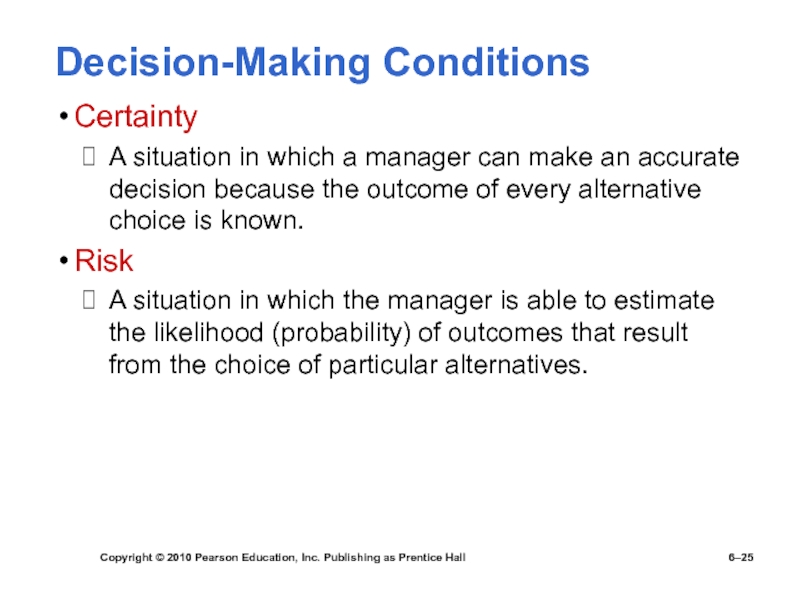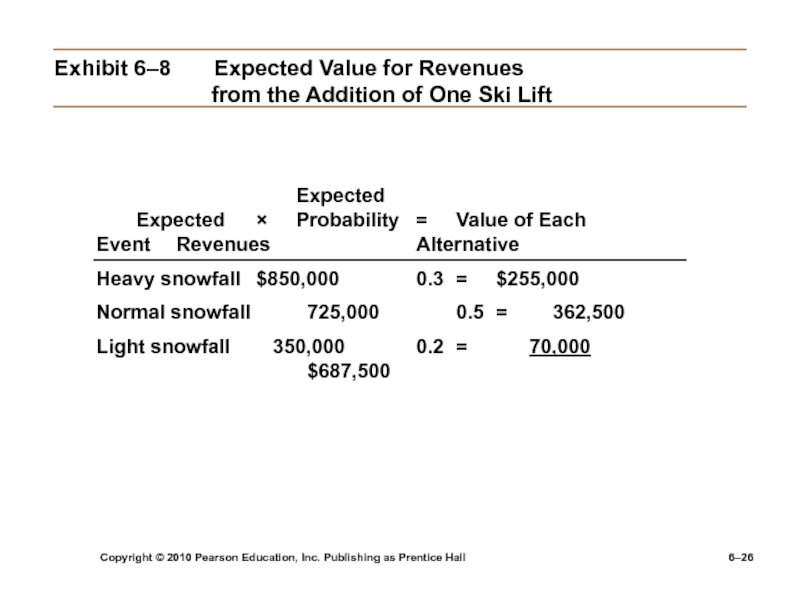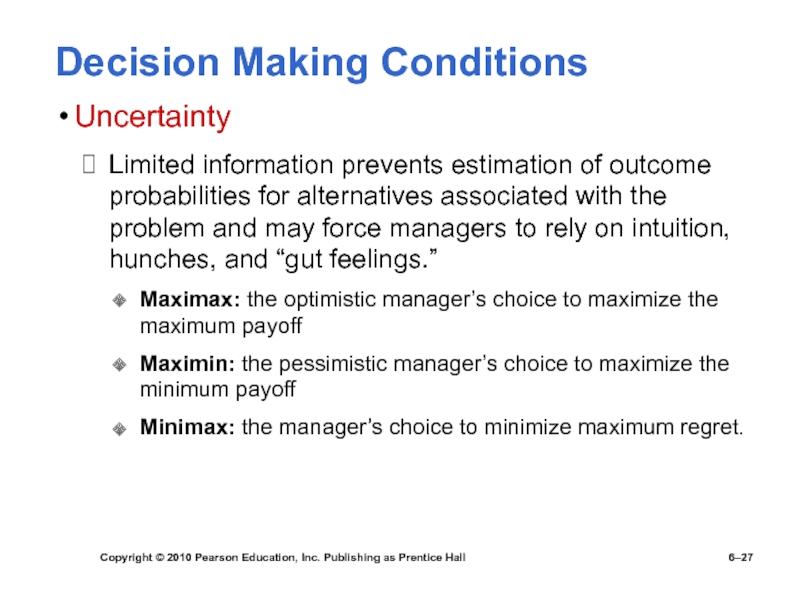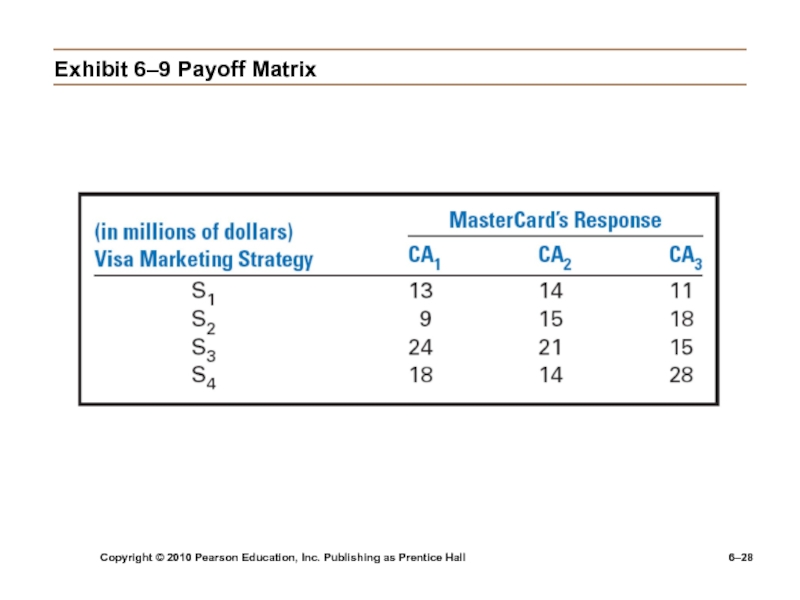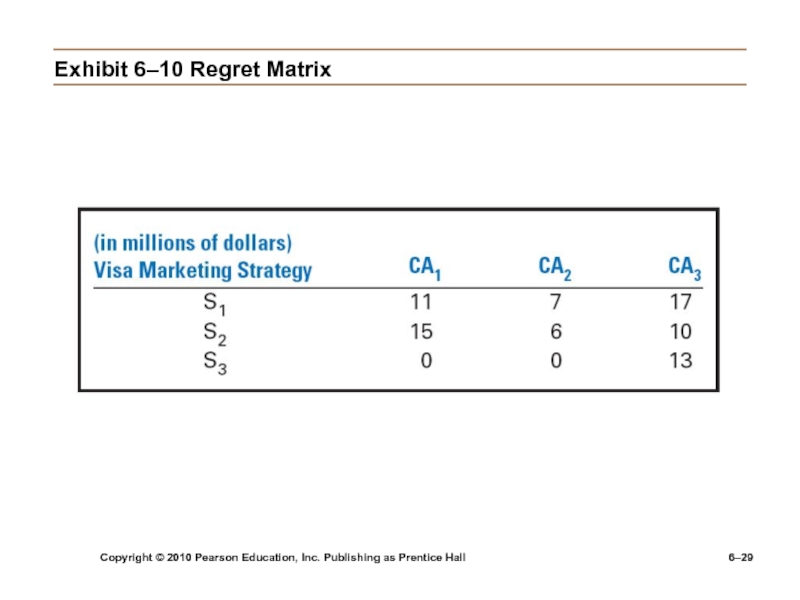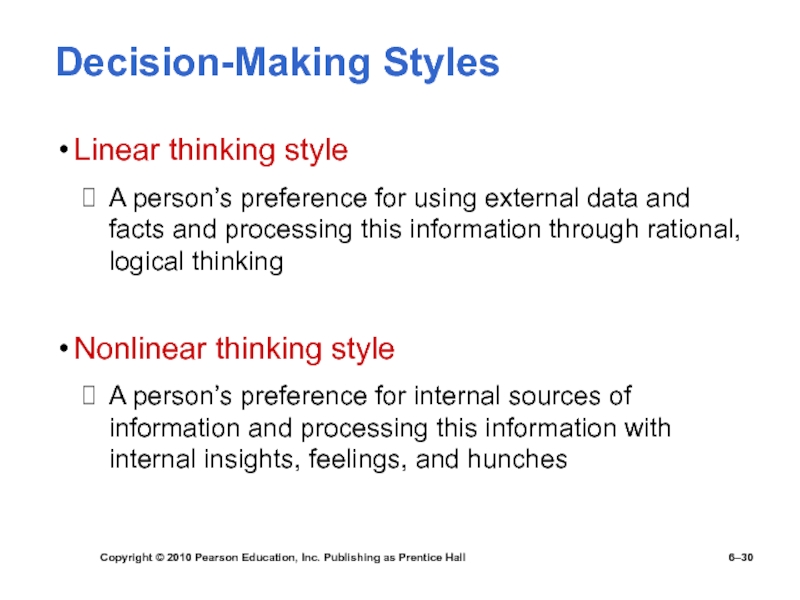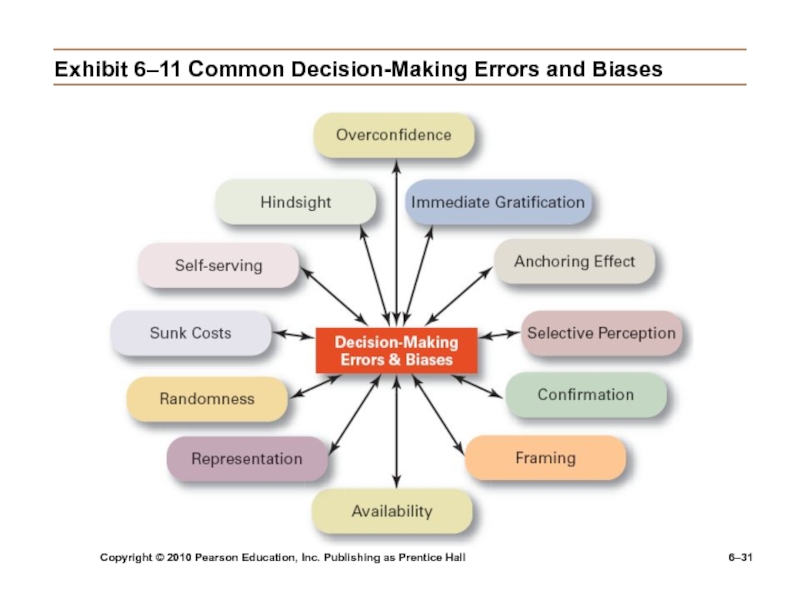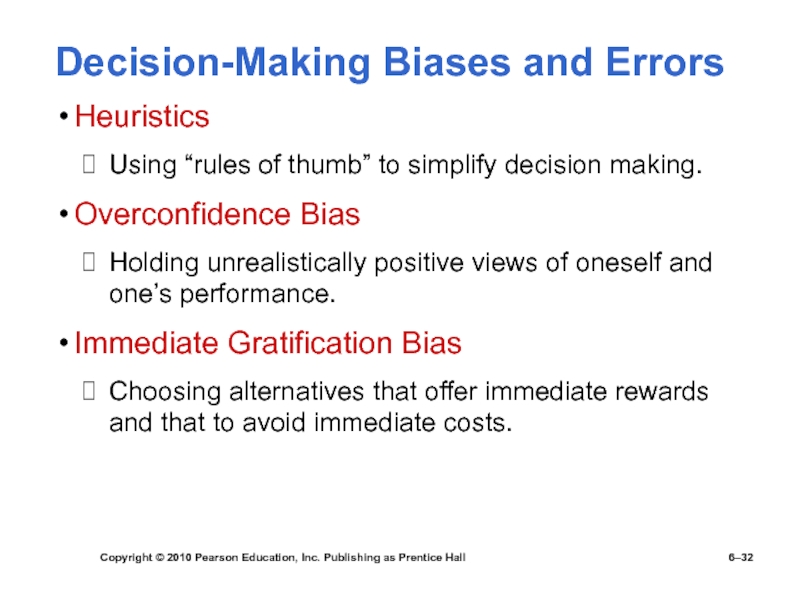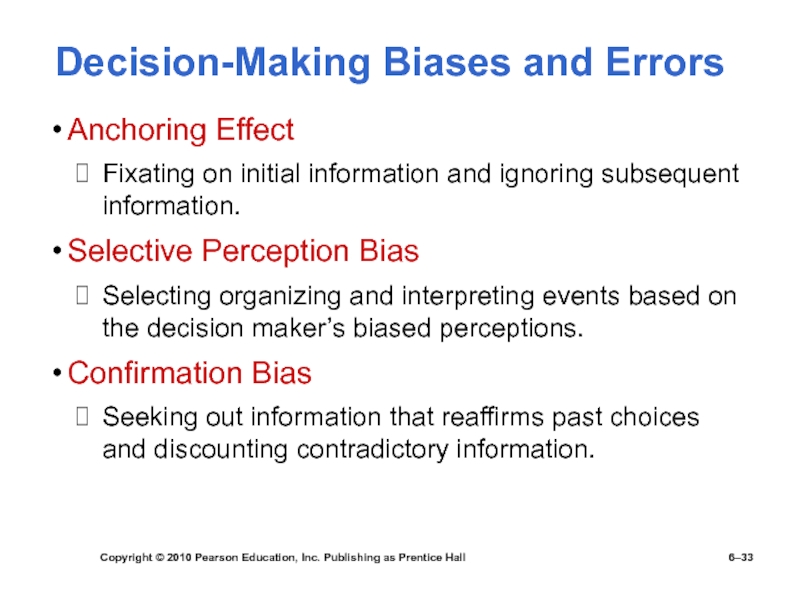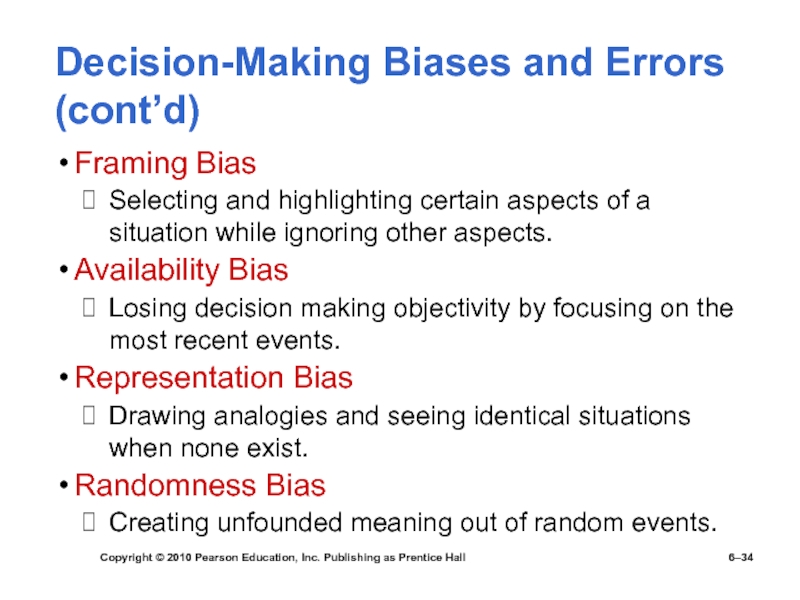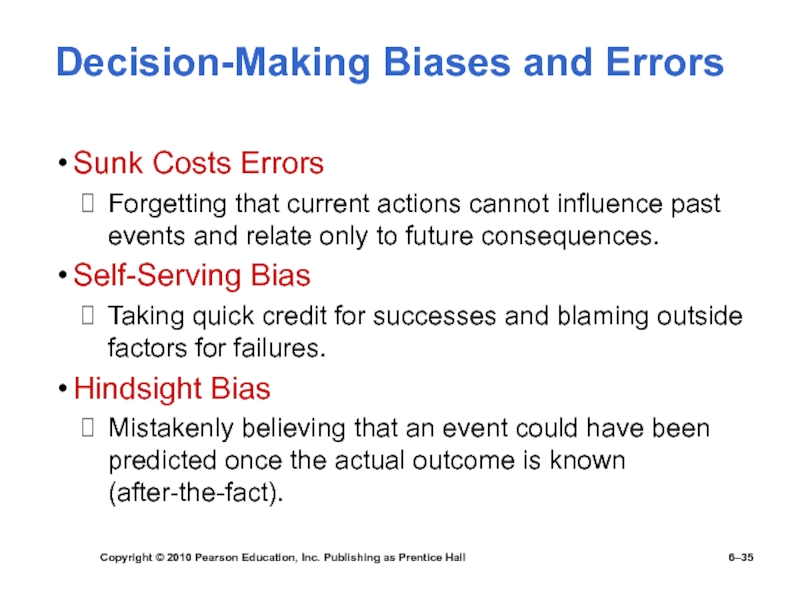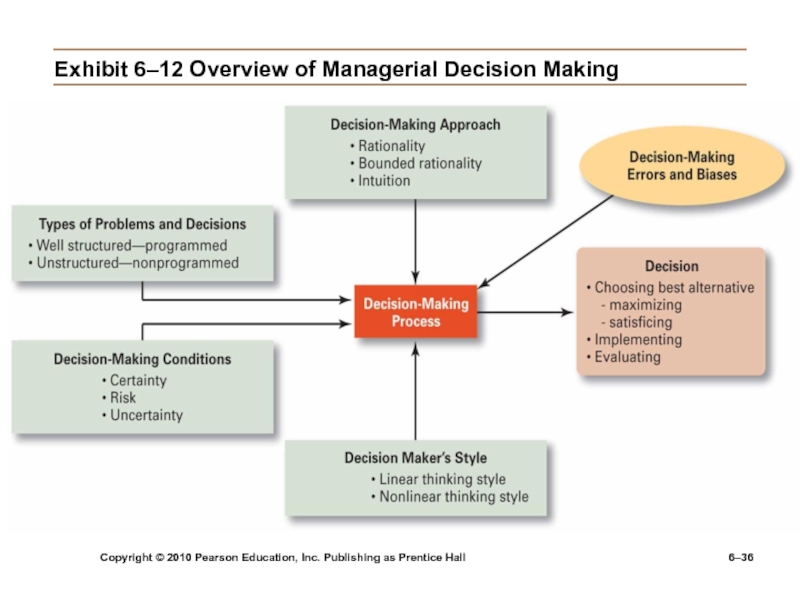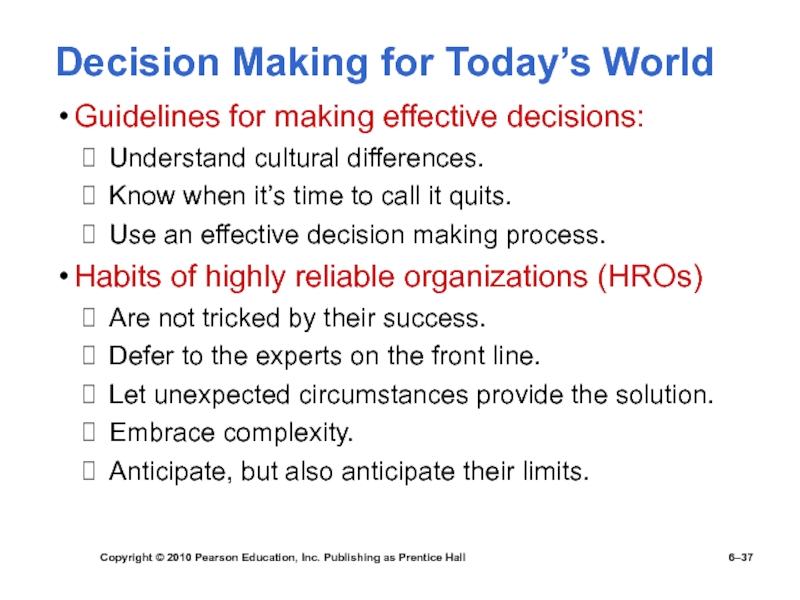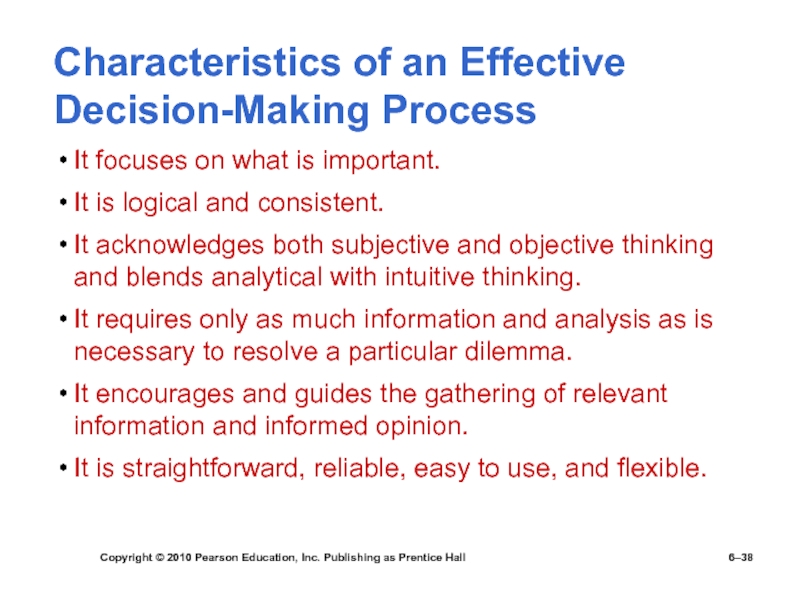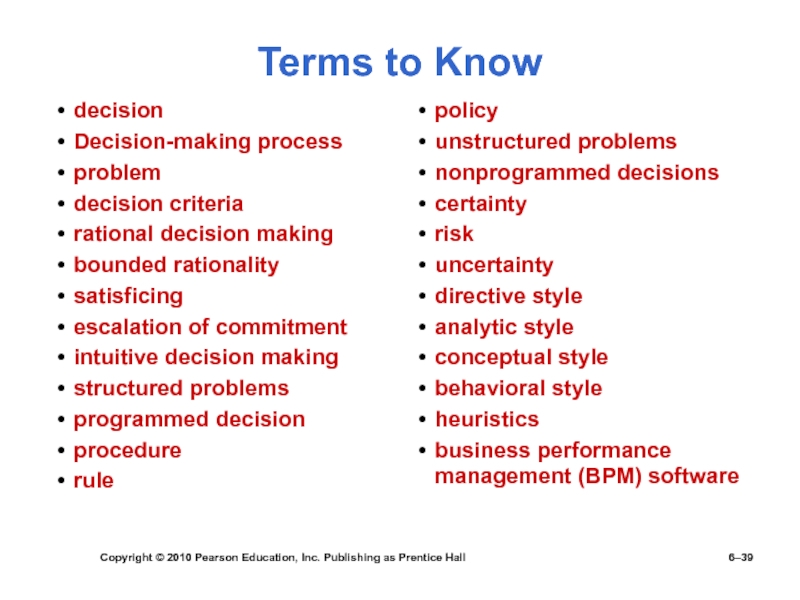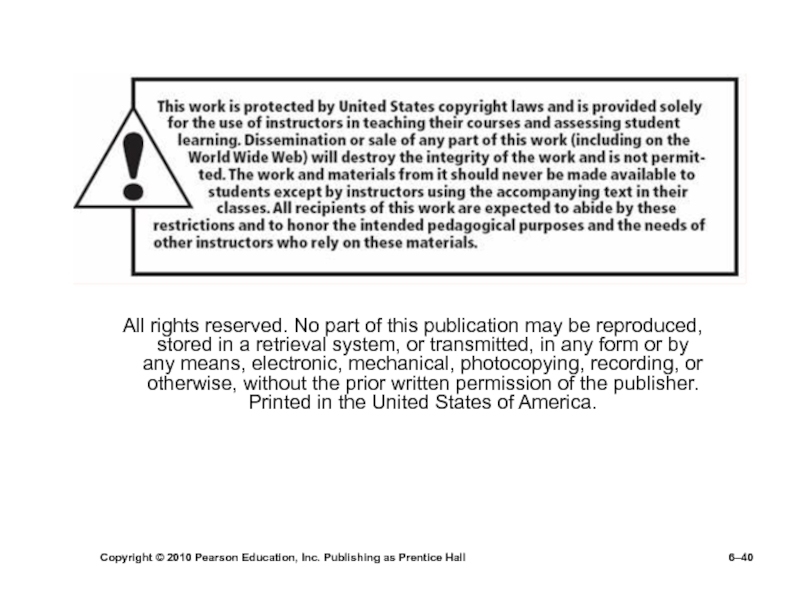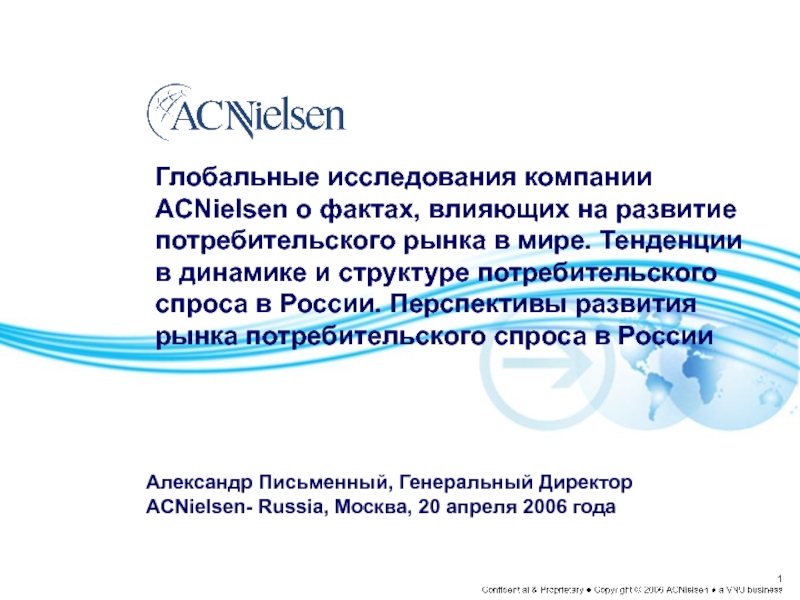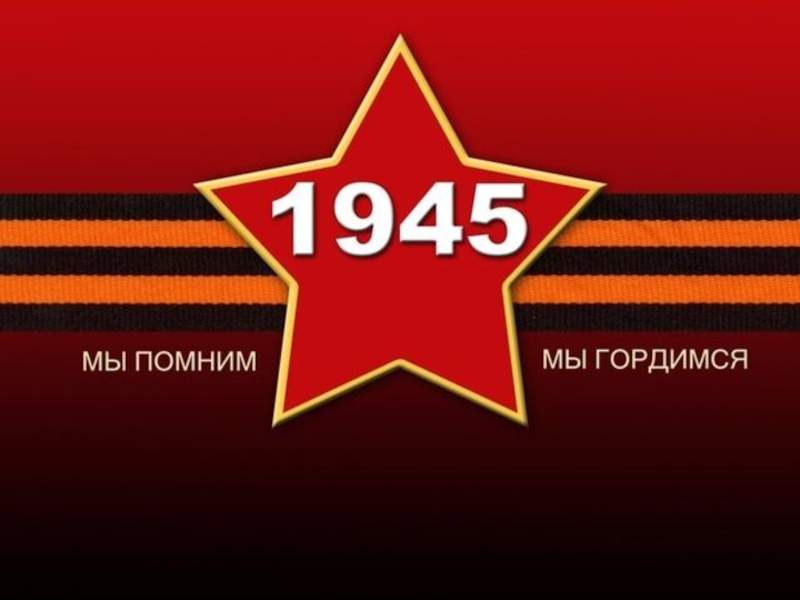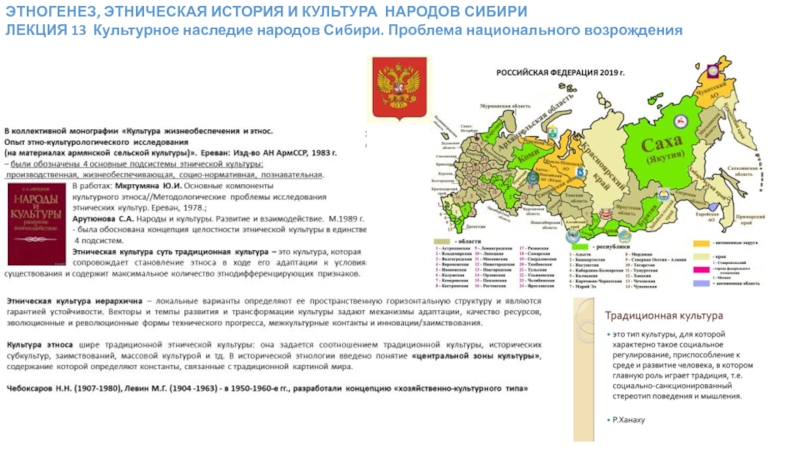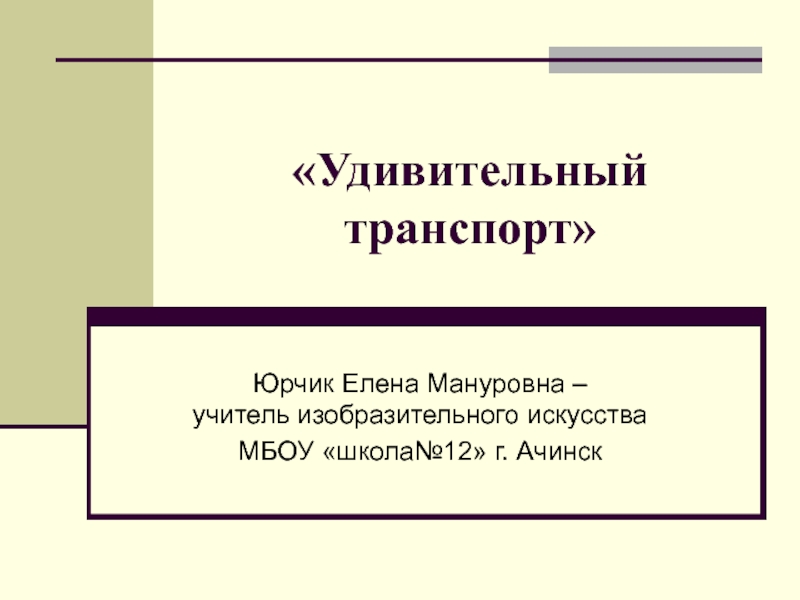Разделы презентаций
- Разное
- Английский язык
- Астрономия
- Алгебра
- Биология
- География
- Геометрия
- Детские презентации
- Информатика
- История
- Литература
- Математика
- Медицина
- Менеджмент
- Музыка
- МХК
- Немецкий язык
- ОБЖ
- Обществознание
- Окружающий мир
- Педагогика
- Русский язык
- Технология
- Физика
- Философия
- Химия
- Шаблоны, картинки для презентаций
- Экология
- Экономика
- Юриспруденция
Managers as Decision Makers
Содержание
- 1. Managers as Decision Makers
- 2. Copyright © 2010 Pearson Education, Inc. Publishing
- 3. Copyright © 2010 Pearson Education, Inc. Publishing
- 4. Copyright © 2010 Pearson Education, Inc. Publishing
- 5. Copyright © 2010 Pearson Education, Inc. Publishing
- 6. Copyright © 2010 Pearson Education, Inc. Publishing as Prentice Hall6–Exhibit 6–1 The Decision-Making Process
- 7. Copyright © 2010 Pearson Education, Inc. Publishing
- 8. Copyright © 2010 Pearson Education, Inc. Publishing
- 9. Copyright © 2010 Pearson Education, Inc. Publishing
- 10. Copyright © 2010 Pearson Education, Inc. Publishing
- 11. Copyright © 2010 Pearson Education, Inc. Publishing
- 12. Copyright © 2010 Pearson Education, Inc. Publishing
- 13. Copyright © 2010 Pearson Education, Inc. Publishing
- 14. Copyright © 2010 Pearson Education, Inc. Publishing
- 15. Copyright © 2010 Pearson Education, Inc. Publishing
- 16. Copyright © 2010 Pearson Education, Inc. Publishing
- 17. Copyright © 2010 Pearson Education, Inc. Publishing
- 18. Copyright © 2010 Pearson Education, Inc. Publishing
- 19. Copyright © 2010 Pearson Education, Inc. Publishing
- 20. Copyright © 2010 Pearson Education, Inc. Publishing
- 21. Copyright © 2010 Pearson Education, Inc. Publishing
- 22. Copyright © 2010 Pearson Education, Inc. Publishing
- 23. Copyright © 2010 Pearson Education, Inc. Publishing
- 24. Copyright © 2010 Pearson Education, Inc. Publishing as Prentice Hall6–Exhibit 6–7 Programmed Versus Nonprogrammed Decisions
- 25. Copyright © 2010 Pearson Education, Inc. Publishing
- 26. Copyright © 2010 Pearson Education, Inc. Publishing
- 27. Copyright © 2010 Pearson Education, Inc. Publishing
- 28. Copyright © 2010 Pearson Education, Inc. Publishing as Prentice Hall6–Exhibit 6–9 Payoff Matrix
- 29. Copyright © 2010 Pearson Education, Inc. Publishing as Prentice Hall6–Exhibit 6–10 Regret Matrix
- 30. Copyright © 2010 Pearson Education, Inc. Publishing
- 31. Copyright © 2010 Pearson Education, Inc. Publishing as Prentice Hall6–Exhibit 6–11 Common Decision-Making Errors and Biases
- 32. Copyright © 2010 Pearson Education, Inc. Publishing
- 33. Copyright © 2010 Pearson Education, Inc. Publishing
- 34. Copyright © 2010 Pearson Education, Inc. Publishing
- 35. Copyright © 2010 Pearson Education, Inc. Publishing
- 36. Copyright © 2010 Pearson Education, Inc. Publishing as Prentice Hall6–Exhibit 6–12 Overview of Managerial Decision Making
- 37. Copyright © 2010 Pearson Education, Inc. Publishing
- 38. Copyright © 2010 Pearson Education, Inc. Publishing
- 39. Copyright © 2010 Pearson Education, Inc. Publishing
- 40. Copyright © 2010 Pearson Education, Inc. Publishing
- 41. Скачать презентанцию
Слайды и текст этой презентации
Слайд 1Copyright © 2010 Pearson Education, Inc. Publishing as Prentice Hall
6–
Managers
as
Decision Makers
editionСлайд 2Copyright © 2010 Pearson Education, Inc. Publishing as Prentice Hall
6–
Learning
Outcomes Follow this Learning Outline as you read and study this
chapter.6.1 The Decision-Making Process.
Define decision.
Describe the eight steps in the decision-making process.
6.2 Managers Making Decisions.
Discuss the assumptions of rational decision making.
Describe the concepts of bounded rationality, satisficing, and escalation of commitment.
Explain intuitive decision making.
Слайд 3Copyright © 2010 Pearson Education, Inc. Publishing as Prentice Hall
6–
Learning
Outcomes
6.3 Types Of Decisions and Decision-Making
Conditions.Explain the two types of problems and decisions.
Contrast the three decision making conditions.
Explain maximax, maximin, and minimax decision choice approaches.
6.4 Decision-Making Styles
Describe two decision-making styles.
Discuss the twelve decision-making biases.
Explain the managerial decision-making model.
Слайд 4Copyright © 2010 Pearson Education, Inc. Publishing as Prentice Hall
6–
Learning
Outcomes
6.5 Effective Decision Making In Today’s World.
Explain how managers can
make effective decisions in today’s world.List the six characteristics of an effective decision making process.
List the five habits of highly reliable organizations.
Слайд 5Copyright © 2010 Pearson Education, Inc. Publishing as Prentice Hall
6–
Decision
Making
Decision
Making a choice from two or more alternatives.
The Decision-Making Process
Identifying
a problem and decision criteria and allocating weights to the criteria.Developing, analyzing, and selecting an alternative that can resolve the problem.
Implementing the selected alternative.
Evaluating the decision’s effectiveness.
Слайд 6Copyright © 2010 Pearson Education, Inc. Publishing as Prentice Hall
6–
Exhibit
6–1
The Decision-Making
Process
Слайд 7Copyright © 2010 Pearson Education, Inc. Publishing as Prentice Hall
6–
Step
1: Identifying the Problem
Problem
A discrepancy between an existing and desired
state of affairs.Characteristics of Problems
A problem becomes a problem when a manager becomes aware of it.
There is pressure to solve the problem.
The manager must have the authority, information, or resources needed to solve the problem.
Слайд 8Copyright © 2010 Pearson Education, Inc. Publishing as Prentice Hall
6–
Step
2: Identifying Decision Criteria
Decision criteria are factors that are important
(relevant) to resolving the problem such as:Costs that will be incurred (investments required)
Risks likely to be encountered (chance of failure)
Outcomes that are desired (growth of the firm)
Step 3: Allocating Weights to the Criteria
Decision criteria are not of equal importance:
Assigning a weight to each item places the items in the correct priority order of their importance in the decision-making process.
Слайд 9Copyright © 2010 Pearson Education, Inc. Publishing as Prentice Hall
6–
Exhibit
6–2 Criteria and Weights for Computer Replacement Decision
Слайд 10Copyright © 2010 Pearson Education, Inc. Publishing as Prentice Hall
6–
Step
4: Developing Alternatives
Identifying viable alternatives
Alternatives are listed (without evaluation) that
can resolve the problem.Step 5: Analyzing Alternatives
Appraising each alternative’s strengths and weaknesses
An alternative’s appraisal is based on its ability to resolve the issues identified in steps 2 and 3.
Слайд 11Copyright © 2010 Pearson Education, Inc. Publishing as Prentice Hall
6–
Exhibit
6–3 Assessed Values of Laptop Computers
Using Decision CriteriaСлайд 12Copyright © 2010 Pearson Education, Inc. Publishing as Prentice Hall
6–
Step
6: Selecting an Alternative
Choosing the best alternative
The alternative with the
highest total weight is chosen.Step 7: Implementing the Alternative
Putting the chosen alternative into action.
Conveying the decision to and gaining commitment from those who will carry out the decision.
Слайд 13Copyright © 2010 Pearson Education, Inc. Publishing as Prentice Hall
6–
Exhibit
6–4 Evaluation of Laptop Alternatives
Against Weighted Criteria
Слайд 14Copyright © 2010 Pearson Education, Inc. Publishing as Prentice Hall
6–
Step
8: Evaluating the Decision’s Effectiveness
The soundness of the decision is
judged by its outcomes.How effectively was the problem resolved by outcomes resulting from the chosen alternatives?
If the problem was not resolved, what went wrong?
Слайд 15Copyright © 2010 Pearson Education, Inc. Publishing as Prentice Hall
6–
Exhibit
6–5 Decisions in the Management
Functions
Слайд 16Copyright © 2010 Pearson Education, Inc. Publishing as Prentice Hall
6–
Making
Decisions
Rationality
Managers make consistent, value-maximizing choices with specified constraints.
Assumptions are that
decision makers:Are perfectly rational, fully objective, and logical.
Have carefully defined the problem and identified all viable alternatives.
Have a clear and specific goal
Will select the alternative that maximizes outcomes in the organization’s interests rather than in their personal interests.
Слайд 17Copyright © 2010 Pearson Education, Inc. Publishing as Prentice Hall
6–
Making
Decisions (cont’d)
Bounded Rationality
Managers make decisions rationally, but are limited (bounded)
by their ability to process information.Assumptions are that decision makers:
Will not seek out or have knowledge of all alternatives
Will satisfice—choose the first alternative encountered that satisfactorily solves the problem—rather than maximize the outcome of their decision by considering all alternatives and choosing the best.
Influence on decision making
Escalation of commitment: an increased commitment to a previous decision despite evidence that it may have been wrong.
Слайд 18Copyright © 2010 Pearson Education, Inc. Publishing as Prentice Hall
6–
The
Role of Intuition
Intuitive decision making
Making decisions on the basis of
experience, feelings, and accumulated judgment. Слайд 19Copyright © 2010 Pearson Education, Inc. Publishing as Prentice Hall
6–
Exhibit
6–6 What Is Intuition?
Source: Based on L. A. Burke and M.
K. Miller, “Taking the Mystery Out of Intuitive Decision Making,” Academy of Management Executive, October 1999, pp. 91–99.Слайд 20Copyright © 2010 Pearson Education, Inc. Publishing as Prentice Hall
6–
Types
of Problems and Decisions
Structured Problems
Involve goals that are clear.
Are familiar
(have occurred before).Are easily and completely defined—information about the problem is available and complete.
Programmed Decision
A repetitive decision that can be handled by a routine approach.
Слайд 21Copyright © 2010 Pearson Education, Inc. Publishing as Prentice Hall
6–
Types
of Programmed Decisions
Procedure
A series of interrelated steps that a manager
can use to respond (applying a policy) to a structured problem.Rule
An explicit statement that limits what a manager or employee can or cannot do.
Policy
A general guideline for making a decision about a structured problem.
Слайд 22Copyright © 2010 Pearson Education, Inc. Publishing as Prentice Hall
6–
Policy,
Procedure, and Rule Examples
Policy
Accept all customer-returned merchandise.
Procedure
Follow all steps for
completing merchandise return documentation.Rules
Managers must approve all refunds over $50.00.
No credit purchases are refunded for cash.
Слайд 23Copyright © 2010 Pearson Education, Inc. Publishing as Prentice Hall
6–
Problems
and Decisions (cont’d)
Unstructured Problems
Problems that are new or unusual and
for which information is ambiguous or incomplete.Problems that will require custom-made solutions.
Nonprogrammed Decisions
Decisions that are unique and nonrecurring.
Decisions that generate unique responses.
Слайд 24Copyright © 2010 Pearson Education, Inc. Publishing as Prentice Hall
6–
Exhibit
6–7 Programmed Versus Nonprogrammed Decisions
Слайд 25Copyright © 2010 Pearson Education, Inc. Publishing as Prentice Hall
6–
Decision-Making
Conditions
Certainty
A situation in which a manager can make an accurate
decision because the outcome of every alternative choice is known.Risk
A situation in which the manager is able to estimate the likelihood (probability) of outcomes that result from the choice of particular alternatives.
Слайд 26Copyright © 2010 Pearson Education, Inc. Publishing as Prentice Hall
6–
Exhibit
6–8 Expected Value for Revenues from
the Addition of One Ski Lift Expected
Expected × Probability = Value of Each
Event Revenues Alternative
Heavy snowfall $850,000 0.3 = $255,000
Normal snowfall 725,000 0.5 = 362,500
Light snowfall 350,000 0.2 = 70,000
$687,500
Слайд 27Copyright © 2010 Pearson Education, Inc. Publishing as Prentice Hall
6–
Decision
Making Conditions
Uncertainty
Limited information prevents estimation of outcome probabilities for alternatives
associated with the problem and may force managers to rely on intuition, hunches, and “gut feelings.”Maximax: the optimistic manager’s choice to maximize the maximum payoff
Maximin: the pessimistic manager’s choice to maximize the minimum payoff
Minimax: the manager’s choice to minimize maximum regret.
Слайд 28Copyright © 2010 Pearson Education, Inc. Publishing as Prentice Hall
6–
Exhibit
6–9 Payoff Matrix
Слайд 29Copyright © 2010 Pearson Education, Inc. Publishing as Prentice Hall
6–
Exhibit
6–10 Regret Matrix
Слайд 30Copyright © 2010 Pearson Education, Inc. Publishing as Prentice Hall
6–
Decision-Making
Styles
Linear thinking style
A person’s preference for using external data and
facts and processing this information through rational, logical thinkingNonlinear thinking style
A person’s preference for internal sources of information and processing this information with internal insights, feelings, and hunches
Слайд 31Copyright © 2010 Pearson Education, Inc. Publishing as Prentice Hall
6–
Exhibit
6–11 Common Decision-Making Errors and Biases
Слайд 32Copyright © 2010 Pearson Education, Inc. Publishing as Prentice Hall
6–
Decision-Making
Biases and Errors
Heuristics
Using “rules of thumb” to simplify decision making.
Overconfidence
BiasHolding unrealistically positive views of oneself and one’s performance.
Immediate Gratification Bias
Choosing alternatives that offer immediate rewards and that to avoid immediate costs.
Слайд 33Copyright © 2010 Pearson Education, Inc. Publishing as Prentice Hall
6–
Decision-Making
Biases and Errors
Anchoring Effect
Fixating on initial information and ignoring
subsequent information.Selective Perception Bias
Selecting organizing and interpreting events based on the decision maker’s biased perceptions.
Confirmation Bias
Seeking out information that reaffirms past choices and discounting contradictory information.
Слайд 34Copyright © 2010 Pearson Education, Inc. Publishing as Prentice Hall
6–
Decision-Making
Biases and Errors (cont’d)
Framing Bias
Selecting and highlighting certain aspects of
a situation while ignoring other aspects.Availability Bias
Losing decision making objectivity by focusing on the most recent events.
Representation Bias
Drawing analogies and seeing identical situations when none exist.
Randomness Bias
Creating unfounded meaning out of random events.
Слайд 35Copyright © 2010 Pearson Education, Inc. Publishing as Prentice Hall
6–
Decision-Making
Biases and Errors
Sunk Costs Errors
Forgetting that current actions cannot
influence past events and relate only to future consequences.Self-Serving Bias
Taking quick credit for successes and blaming outside factors for failures.
Hindsight Bias
Mistakenly believing that an event could have been predicted once the actual outcome is known (after-the-fact).
Слайд 36Copyright © 2010 Pearson Education, Inc. Publishing as Prentice Hall
6–
Exhibit
6–12 Overview of Managerial Decision Making
Слайд 37Copyright © 2010 Pearson Education, Inc. Publishing as Prentice Hall
6–
Decision
Making for Today’s World
Guidelines for making effective decisions:
Understand cultural differences.
Know
when it’s time to call it quits.Use an effective decision making process.
Habits of highly reliable organizations (HROs)
Are not tricked by their success.
Defer to the experts on the front line.
Let unexpected circumstances provide the solution.
Embrace complexity.
Anticipate, but also anticipate their limits.
Слайд 38Copyright © 2010 Pearson Education, Inc. Publishing as Prentice Hall
6–
Characteristics
of an Effective Decision-Making Process
It focuses on what is important.
It
is logical and consistent.It acknowledges both subjective and objective thinking and blends analytical with intuitive thinking.
It requires only as much information and analysis as is necessary to resolve a particular dilemma.
It encourages and guides the gathering of relevant information and informed opinion.
It is straightforward, reliable, easy to use, and flexible.
Слайд 39Copyright © 2010 Pearson Education, Inc. Publishing as Prentice Hall
6–
Terms
to Know
decision
Decision-making process
problem
decision criteria
rational decision making
bounded rationality
satisficing
escalation of commitment
intuitive decision
makingstructured problems
programmed decision
procedure
rule
policy
unstructured problems
nonprogrammed decisions
certainty
risk
uncertainty
directive style
analytic style
conceptual style
behavioral style
heuristics
business performance management (BPM) software
